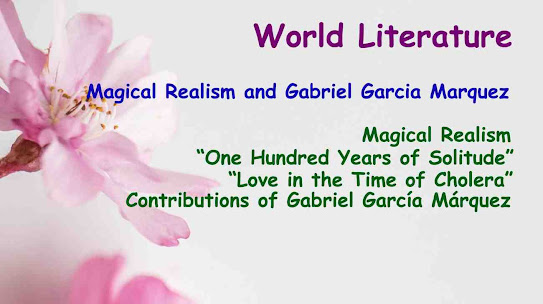Magical
Realism and Gabriel Garcia Marquez
Gabriel García Márquez was born in 1927 in Aracataca, Colombia. He is considered as one of the most influential writers of the World Literature during 20th century. He is renowned for pioneering magical realism in literature.
Immersed in the rich oral traditions of his upbringing by his grandparents in Aracataca, García Márquez drew inspiration from the region's stories and myths. His career began in journalism, shaping his narrative style with vivid imagery and a keen understanding of societal complexities.
In 1967, García Márquez achieved international acclaim with "One Hundred Years of Solitude," a masterpiece blending myth, history, and fantasy in the saga of the Buendía family in Macondo. This novel catapulted him to literary stardom and popularized magical realism globally.
Throughout his prolific career, García Márquez produced numerous acclaimed works, including "Love in the Time of Cholera" and "Chronicle of a Death Foretold," showcasing his mastery of storytelling across various genres.
Beyond literature, García Márquez was a vocal advocate for social justice and human rights, engaging in political activism alongside his writing. His friendship with Fidel Castro and criticism of US intervention in Latin America underscored his commitment to political causes.
Until
his passing in 2014, García Márquez continued to write and inspire readers
globally, leaving behind a legacy as a literary luminary and a champion of
social change.
Magical
Realism
From the mystical town of Macondo in "One Hundred Years of Solitude" to the surreal tapestry of "Love in the Time of Cholera," Marquez's work transcends boundaries, challenging our perceptions of reality.
Gabriel Garcia Marquez, a luminary of magical realism, takes readers on a journey to the mystical town of Macondo in "One Hundred Years of Solitude."
In
this masterpiece, reality intertwines seamlessly with the fantastical, blurring
the lines between the ordinary and the extraordinary. Marquez's narrative
transcends geographical boundaries, offering readers a glimpse into a world
where the magical coexists with the mundane.
“One
Hundred Years of Solitude”
Gabriel Garcia Marquez, a maestro of magical realism, unveils the enchanting realm of Macondo in his masterpiece, “One Hundred Years of Solitude.” This mystical town becomes a canvas where reality and fantasy converge, creating a narrative tapestry that defies conventional storytelling.
In Macondo, the ordinary and the extraordinary intertwine seamlessly, giving life to a world where the magical is an integral part of everyday existence. Marquez’s narrative prowess transcends geographical boundaries, inviting readers to suspend disbelief and immerse themselves in a landscape where the mundane and the mystical dance in harmonious splendor.
“One
Hundred Years of Solitude” stands as a testament to Marquez’s ability to weave
a narrative that transcends the limitations of reality, offering a captivating
glimpse into a universe where the extraordinary unfolds within the folds of the
ordinary.
“Love
in the Time of Cholera”
In "Love in the Time of Cholera," Marquez weaves a surreal tapestry of love and longing. The novel challenges conventional notions of time and romance, presenting a narrative that is as timeless as it is unconventional.
Marquez's magical realism invites readers to question their perceptions of reality, encouraging them to embrace the enchanting and the inexplicable.
"Love in the Time of Cholera" unfolds as a surreal tapestry woven by the literary virtuoso, Gabriel Garcia Marquez. This novel ventures beyond conventional boundaries of time and romance, presenting a narrative that is both timeless and unconventional.
Marquez's mastery of magical realism manifests as the story navigates the realms of love and longing, blurring the lines between reality and enchantment. The novel challenges readers to reconsider their perceptions of the ordinary, inviting them into a world where the inexplicable becomes a natural part of the narrative fabric.
As Marquez crafts a tale that transcends the constraints of reality, "Love in the Time of Cholera" emerges as a testament to the transformative power of storytelling and the enduring allure of the mystical in the realm of literature.
Contributions of Gabriel García Márquez
Gabriel García Márquez, through his pioneering use of magical realism, profoundly impacted literature, culture, and society. His novels unveiled enchanting worlds where reality intertwined with fantasy, captivating readers worldwide.
He explored the complexities of Latin American identity, infusing his narratives with the region's history, culture, and social struggles. His works served as powerful critiques of power dynamics and political oppression, shedding light on the tumultuous landscape of Latin America.
Beyond his literary contributions, his influence extended to inspiring generations of writers globally. He used his platform to advocate for social justice, leaving a lasting legacy as not only a literary giant but also a champion for human rights. Today, his novels remain essential reading, ensuring his enduring impact on literature and society.
Conclusion
Gabriel García Márquez pioneered magical
realism, blending fantasy with reality in works. His writing explored Latin
American identity, history, and social struggles, providing poignant critiques
of power and oppression. His influence extended globally, inspiring generations
of writers and earning him accolades.





No comments:
Post a Comment